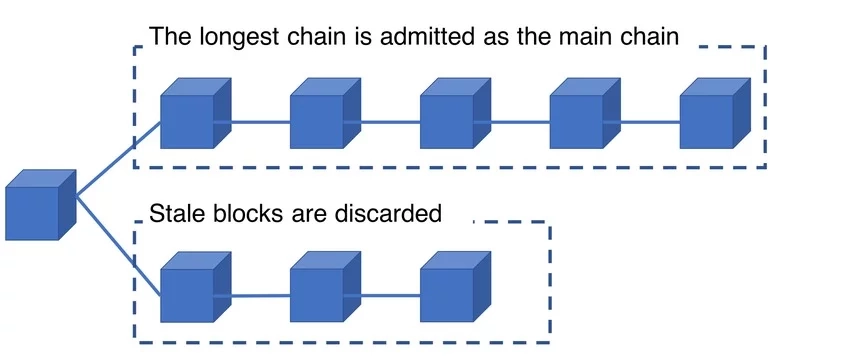When you make a transaction on the blockchain, you have to wait for it to finalize. This time can vary from a few seconds to a few days depending on the consensus mechanism and the network mechanism in general.
This period of time is called Finality. Of course, finality is also used in traditional financial affairs and is not a concept that is only related to blockchain.
In this article, after explaining the basic explanation about this concept and examining the difference between finality in blockchain and traditional finance, we will also take a look at its types in order to better understand why it takes a long time to finalize a transaction on some networks.
Key points of the article
- Finality is the time that must pass to ensure the immutability and reversibility of blocks in the blockchain.
- In proof-of-work networks that operate on the basis of the longest chain, the deeper the transaction is, the more certain its finalization becomes.
- In proof-of-stake blockchains, a certain percentage of validators must validate a certain block at the same time.
- In layer two networks that use optimistic rollup, the finalization time of the block may take up to a week.
- In networks that use zero knowledge rollups, the block finalization time is very short.
- Finality in Bitcoin takes about 60 minutes.
- It takes approximately 10 to 15 minutes for the transaction to be finalized in Ethereum.
- Finality in Arbitrum takes a few minutes at most.
Let’s dive in and discover together:
- What is finality?
- Types of finality in blockchain
- Finality in Proof of Work (PoW) networks
- Finality in Proof of Stake (PoS) networks
- Finality in layer two
- Frequently Asked Questions on Finality
What is finality?
Finality means ensuring the irreversibility and immutability of blockchain transactions. If you have ever made a transaction, you have seen that the transaction does not show up in your wallet or exchange account until a certain number of blocks have been confirmed.
This issue is precisely due to the existence of an issue called Finality. Time to Finality (TTF) is an important option for estimating and checking the speed of blockchains.
In traditional financial affairs, this concept is considered to mean settlement of amounts. This is a vital issue. Because the longer the settlement of a transaction takes, the more likely it is that various risks and malicious actions by malicious actors will occur.
Transaction settlement finalization ensures that transactions will eventually complete at some point, giving us peace of mind about its certainty.
This is the factor that greatly increases users’ trust. Can you trust a bank that can easily access and alter your transaction history?
Therefore, finality is equivalent to certainty in carrying out the transaction and the impossibility of reversibility, so that even the bank itself cannot change anything.
It should also be kept in mind that a blockchain that accommodates many transactions in a single block can have a high TPS (number of transactions per second).
But this issue does not necessarily mean that this blockchain is fast in the eyes of the user. Also, finality should not be considered the same as block time. You should also remember that transactions cannot be considered final just because they are confirmed in new blocks.
Types of finality in blockchain
The concept of finality in blockchain is a little different than it seems. Since there are no intermediaries in the blockchain, we need something that informs us of the irreversibility and completion of transactions and gives us peace of mind.
We know that once a block is added to the blockchain, it cannot be changed or revoked. The user must wait for a certain number of blocks to be confirmed, which indicates that the transaction is complete.
The types of finalization are usually classified according to the consensus mechanism. Also, layer two blockchains have a different mechanism for finalization. In the following, we will explain a little about the types of finality.
Finality in Proof of Work (PoW) networks

In PoW networks, finality is achieved when more blocks are created. Reversing payments made in older blocks is difficult.
So, as the transactions become so-called deeper (that is, new blocks are created), the probability of the transaction being reversed becomes less and less.
In proof of work, we are dealing with a concept called the longest or heaviest chain. In this mechanism, when miners mine a block, they add it to the longest existing chain.
This issue reiterates that there may be more than one chain at any given time. In such a situation, the chain can be split into two different forks and different miners mine blocks simultaneously in each chain.
When two miners publish a single block at the same time, two separate paths are created. In this situation, both forks continue to validate blocks and new blocks are added to the chains.
New blocks are added to the network until one chain is longer than the other. When the longest chain is identified, it is officially accepted. In this way, transactions on the shorter chain are rejected.
Of course, there is also a possibility that the rejected transactions in the shorter chain are placed in blocks of other chains. The long chain is the chain that contains the most valid blocks.
In the case of Bitcoin, users have to wait 6 blocks for the transaction to be finalized, which takes about an hour. After this period, the finality will be achieved in this network. In chain-based networks (such as Bitcoin), the term Probabilistic Finality is also used for this finality model.
Finality in Proof of Stake (PoS) networks
Blockchains that work on the basis of Proof of Stake have different mechanisms to access finality. Proof of stake may be implemented in different ways such as DPoS, PoA or others, which can also achieve finality according to the mechanism of each.
In Ethereum, finality means guaranteeing that a block cannot be changed or removed from the blockchain without burning at least 33% of the total staked ethers.
In this network, we are faced with a concept called SSF, which stands for Single Slot Finality and means finality in a single slot. In Ethereum, it takes 15 minutes for each block to be finalized, and the concept of SSF refers to the fact that instead of waiting 15 minutes, blocks can be proposed and finalized in the same slot.
Ethereum has answered the question why faster finality is important. As the distance between block proposal and finality increases, the attacker can censor certain blocks or extract MEV.
Shorter time for finality requires higher computing power for each node, because the confirmation process of blocks should happen faster.
In such a mechanism, finality takes time. The reason is that the validators who represent two-thirds of the staked ethers on the network must vote for the block (attest) so that block is considered final.
Each validator node must verify the other nodes to see if they have achieved that two-thirds. To reverse a completed block, the attacker must lose at least one-third of his staked ethers.
Because we said that the finality requires two-thirds of the validator’s majority vote, and if an attacker wants to prevent this issue, he must put at least half of these two-thirds in the middle.
Finality in proof-of-stake networks is also referred to as Absolute Finality, which is based on Practical Byzantine Fault Tolerance (pBFT). In these systems, as soon as the block and transactions are validated, finality is achieved.
Finality in layer two
Layer 2 solutions also have a different method for Finality depending on what mechanism they use. Rollups work by grouping transactions together into a single superblock.
This is the block that is going to be added to the blockchain. Now, in order for rollups to be able to finalize transactions at a high speed, they must use special encryption techniques such as Snark or zero-knowledge proof.
When transactions are processed off-chain, the time required to confirm blocks is reduced. Instead of waiting for a block to be added to the chain, transaction results are published almost instantly on the main chain.
This issue is known as fast finality in rollups, which is a key feature of this technology.
In order to reduce the finality time, the Arbitrum network uses validators to validate its transactions. That is, instead of waiting for the block to be mined and added to the chain, a number of validators are selected to process the transactions and send the result to the main chain.
In general, in layer two that uses rollups, transactions must wait until they are finally transferred from layer two to layer one.
In fact, what is known as finality in layer two is the duration of the transition from layer two to the base layer. In a network like Metis, which uses optimistic rollups, this time is longer, which is due to the mechanism of these rollups.
In such a mechanism that uses Fault Proof (formerly known as Fraud Proof), users must wait for the Challenge Period, which lasts approximately seven days.
In optimistic rollups, it is assumed that the actors are honest and upright, Unless proven otherwise. In this seven-day period, users can challenge the transaction results of a rollup. If the Fault Proof succeeds, the said transaction will be removed and replaced with another correct transaction.
This is done to maintain security in the network and to ensure that the transaction validation process is correct.
In networks that use zero knowledge rollup (ZK-Rollup), the finalization speed of blocks is much higher. In networks based on zero knowledge, layer two transactions are considered final if the contract in layer one accepts proof of validity.
In such networks, validation is done through Validity Proof, which require much less time to prove the correctness of a transaction. The reason for this can be found in the difference between these two rolls. Where in the optimistic mechanism, there is no need to send all such data. This issue reduces the validation time.
Frequently Asked Questions on Finality
What is meant by finality in blockchain?
It is a term that refers to the certainty of transaction finality and its irreversibility in blockchain networks.
What are the types of finality?
According to the consensus mechanism, finality can be divided into two categories: finality in PoW (called Probabilistic Finality) and finality in PoS (called Absolute Finality).


